Physical Address
304 North Cardinal St.
Dorchester Center, MA 02124
Physical Address
304 North Cardinal St.
Dorchester Center, MA 02124
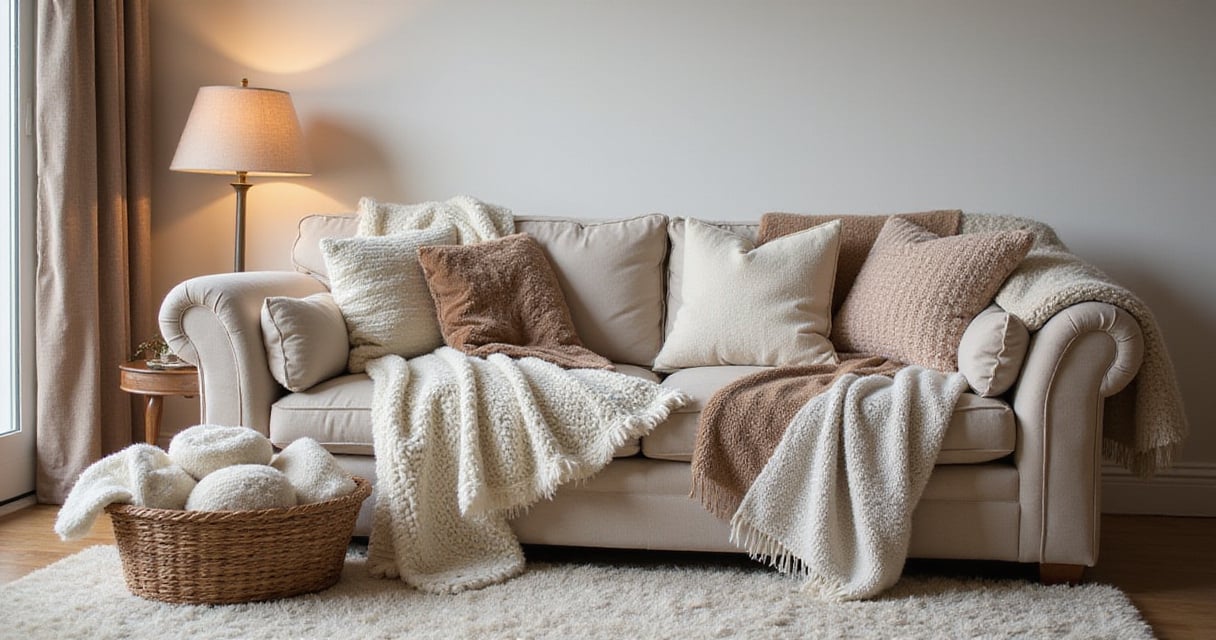
Transform your space into a dream cozy living room with these 24 essential designer secrets. Learn how to layer textures, control lighting, and add personal touches that create true comfort and warmth in your home.
Imagine walking into a room that instantly wraps you in warmth. A space where stress melts away and comfort reigns supreme. This isn’t just any living room—it’s a cozy living room designed with intention, where every element works together to create a sanctuary from the outside world.
As both an artist and designer, I’ve discovered that creating truly inviting spaces isn’t about following trends or spending fortunes. It’s about understanding how different elements affect our senses and emotions. These 24 secrets will guide you through transforming your living room into the retreat you’ve always wanted—a place where creativity flows and relaxation comes naturally.
One of the quickest paths to a cozy living room is through tactile comfort. Strategically placed throws create instant warmth both visually and physically. For maximum coziness, choose materials that speak to your sense of touch—faux fur for luxurious depth, chunky knits for visual texture, or ultra-soft fleece for lightweight warmth.

The magic happens in how you arrange these pieces. Rather than folding everything neatly away, allow a throw to casually drape over an armrest or the back of your sofa. This creates an invitation to relax and suggests the space is meant to be lived in, not just admired. Aim for 2-4 throws in a standard living room, ensuring one is always within reach of each seating area.
“The feeling of soft fabric against skin is one of our most primal comfort associations—it mimics the security we felt as children wrapped in a favorite blanket.”
The inspiration for this collection of textures struck when I noticed how different fabrics transform under changing light throughout the day. Some catches morning sun with a gentle sheen, while others absorb evening lamp light for a deeper richness.
The designer’s secret here is understanding that pillows aren’t just accessories—they’re an experience. A generously pillowed sofa transforms from a simple piece of furniture into a luxurious lounge spot that begs you to sink in. Vary your pillow textures dramatically: velvet against knit, smooth against textured, firm against soft.
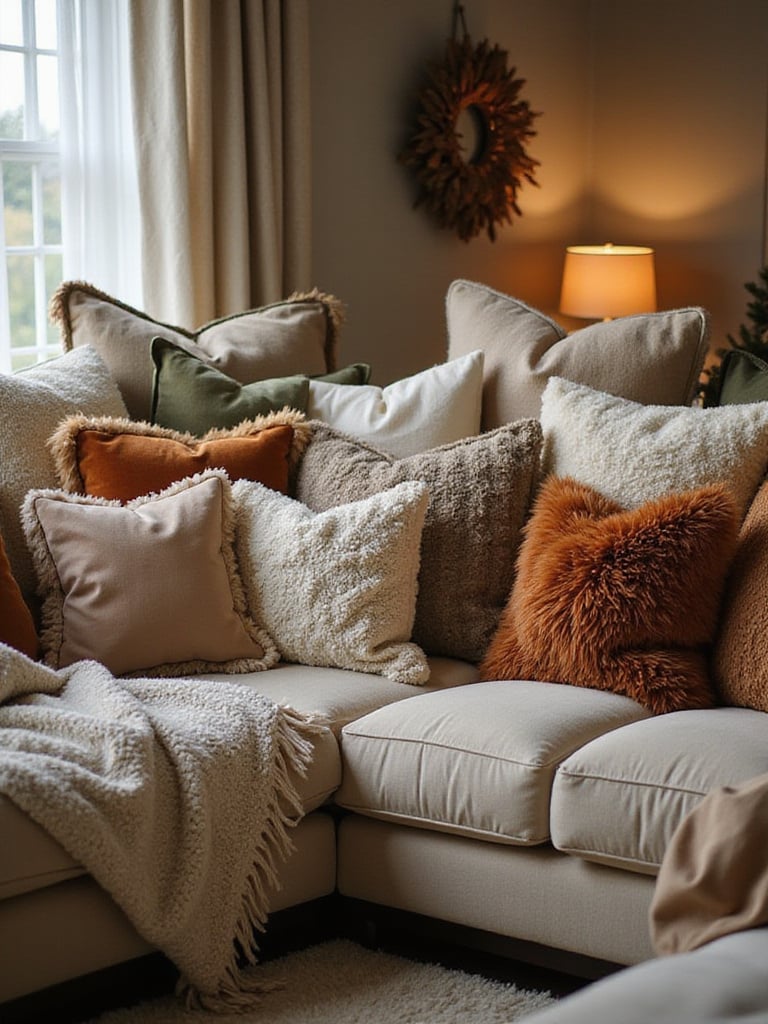
For a standard sofa, start with 3-5 pillows minimum. On larger sectionals, you might use 7-9 to create that abundant, sink-in feeling. The arrangement matters as much as the quantity—start with larger pillows (22×22 inches) at the back corners, then layer medium and smaller sizes forward, mixing shapes like squares with rectangles and maybe a round accent.
What surprises clients most is how these soft elements work with the room’s architecture, softening harsh lines and creating visual rhythm that draws you through the space.
The magic of this piece lies in its ability to visually define your conversation area while adding crucial tactile comfort underfoot. Without a properly sized rug, furniture can feel disconnected—floating islands rather than a cohesive seating arrangement. The right rug instantly grounds the space, creating boundaries that feel intentional rather than restrictive.

For a cozy living room, size matters tremendously. Your rug should be large enough for at least the front legs of all seating to rest comfortably on it—ideally, all furniture legs should sit entirely on the rug. This creates a complete “zone” that feels purposeful and intimate. Standard sizes often range from 8×10 to 9×12 feet, but always measure your specific arrangement before purchasing.
The unexpected environmental benefit comes from the rug’s insulating properties—not only does it feel warmer underfoot, but it actually helps maintain room temperature, creating literal and figurative warmth.
After months of sourcing and curation, I’ve found that color affects our perception of coziness more than almost any other element. Warm, rich hues like deep burgundy, terracotta, forest green, and amber gold create an immediate sense of intimacy and comfort. These colors evoke Natural Elements—earth, fire, wood—that humans have associated with shelter and safety for millennia.
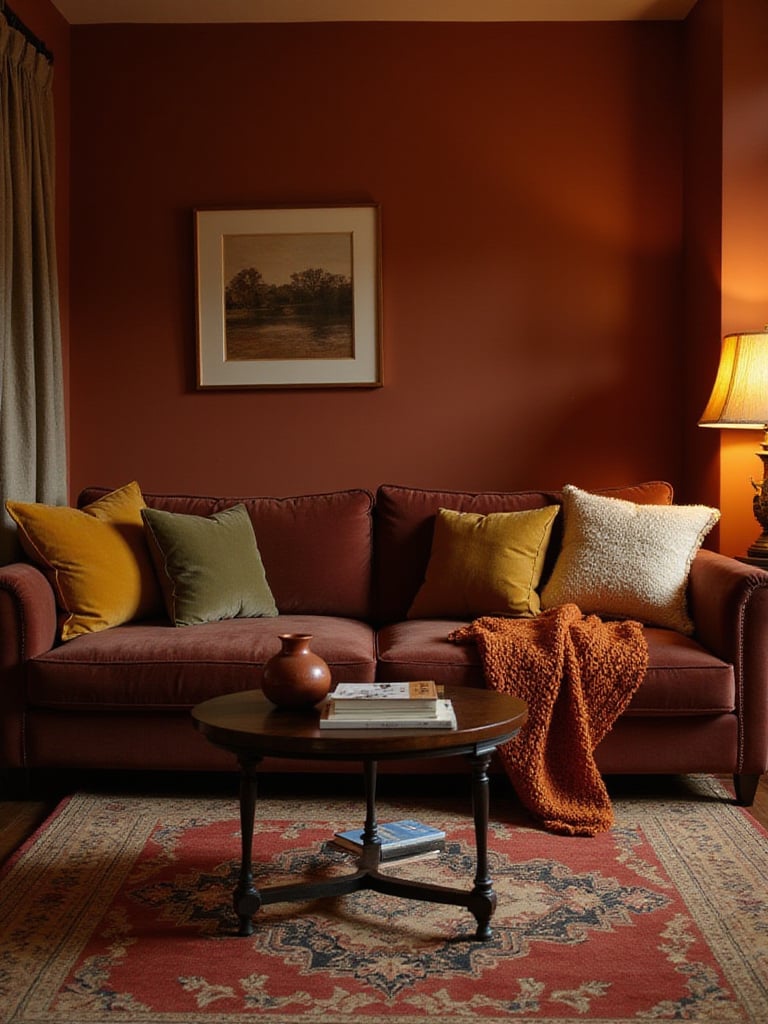
The psychology behind this is fascinating: warm colors actually appear to advance toward the viewer, making walls feel closer and spaces more intimate. Rich, saturated tones add depth and substance that lighter colors simply can’t achieve. They create a sense of being enveloped rather than exposed, crucial for a truly cozy living room.
“I often tell clients to think of color as emotional temperature—warm hues literally make us perceive spaces as physically warmer, while cool tones can make identical rooms feel chillier.”
The artisans behind these designs began with the understanding that balance is key. You don’t need to paint every wall a deep shade—consider an accent wall in a rich hue while keeping other walls in complementary warm neutrals. Or introduce these colors through furniture, textiles, and accessories against a neutral backdrop.
The challenge of awkward spaces becomes easier when you master lighting control. Harsh overhead lighting instantly kills any cozy atmosphere, while the ability to adjust brightness creates dramatic transformations in how a space feels. Dimmable lighting allows you to transition from practical task lighting to intimate evening ambiance with a simple adjustment.
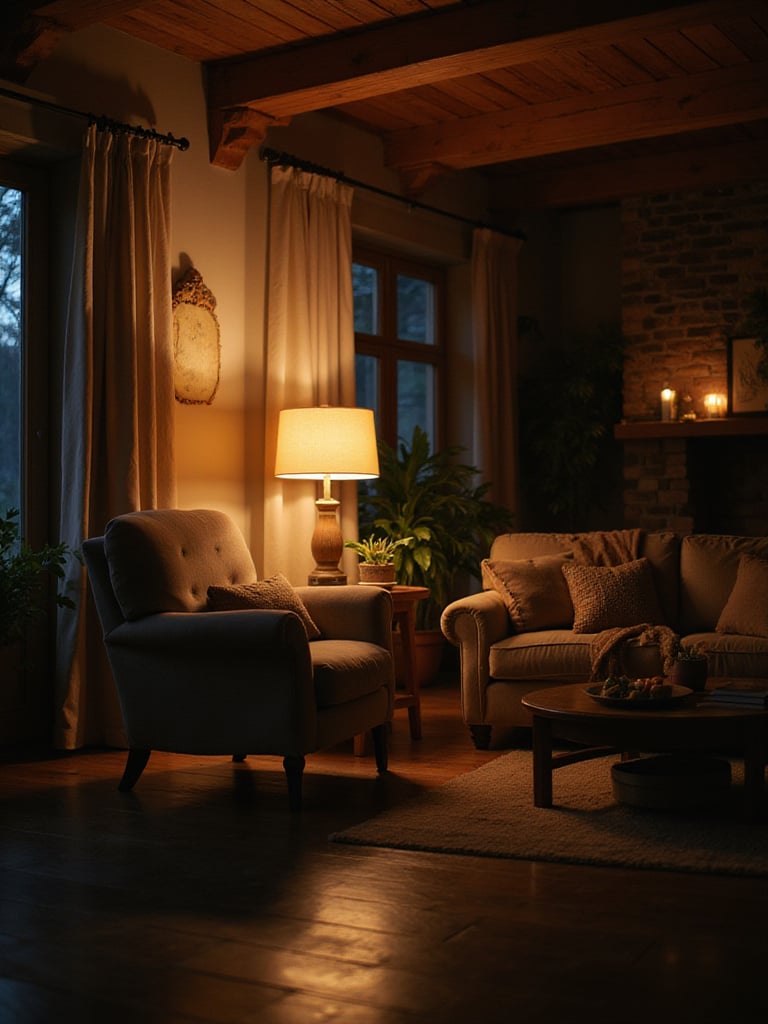
Introducing dimmable options doesn’t require major renovations. Replace standard switches with dimmer controls for existing fixtures, use smart bulbs in regular lamps, or add plug-in dimmer modules between your favorite lamps and outlets. The key is creating layers of light at different heights—overhead, eye-level, and low—all with adjustable brightness.
Unlike single-purpose decor, this adaptable lighting system transforms your cozy living room from energizing morning space to relaxing evening retreat without changing a single piece of furniture.
The craftsmanship reveals itself in details like the grain patterns, natural color variations, and tactile warmth that wood brings to a space. Unlike manufactured materials, wood carries inherent visual interest and a connection to nature that instantly makes a room feel more grounded and authentic. Its natural insulating properties also make it physically warmer to the touch than metal or stone.
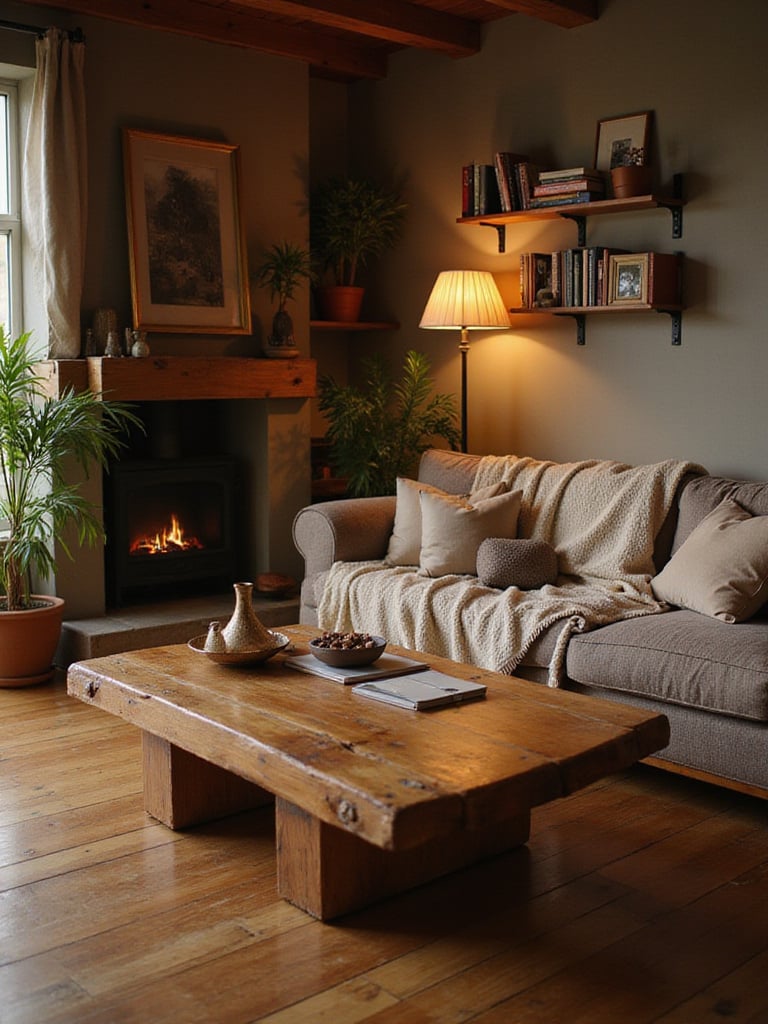
Wood elements can range from substantial furniture pieces to smaller accents. A solid wood coffee table becomes a rich focal point, while floating shelves, picture frames, or decorative bowls add warmth without overwhelming the space. The key is balancing wood tones—mixing light, medium, and dark woods creates depth and prevents the monotony that can make a room feel flat.
The environmental story behind this material began millions of years ago, creating a substance with unmatched character. Each piece tells its own story through knots, grain, and patina—bringing literal and figurative warmth to your cozy living room.
The interplay between living plants and your cozy living room creates a dynamic that no static decor can match. Plants add movement, growth, and a connection to the natural world that fundamentally changes how a space feels. Their organic shapes and varied textures soften architectural lines while literally improving air quality.

For maximum coziness, choose plants with soft, abundant foliage rather than spiky or minimal varieties. Trailing plants like pothos or philodendron create flowing lines when placed on shelves. Leafy plants like peace lilies or fiddle leaf figs add substantial presence without feeling heavy. The key is selecting plants that thrive in your specific light conditions—struggling plants create stress, not comfort.
While designed for the living room, we’ve seen creative uses of plant groupings in transitional spaces like entryways and hallways, creating a continuous thread of life throughout the home.
The subtle fragrance fills the room while engaging our most primal sense—smell. Scent bypasses conscious thought, triggering immediate emotional responses and memories. This makes fragrance an incredibly powerful tool for creating a cozy living room that feels deeply personal and emotionally resonant.
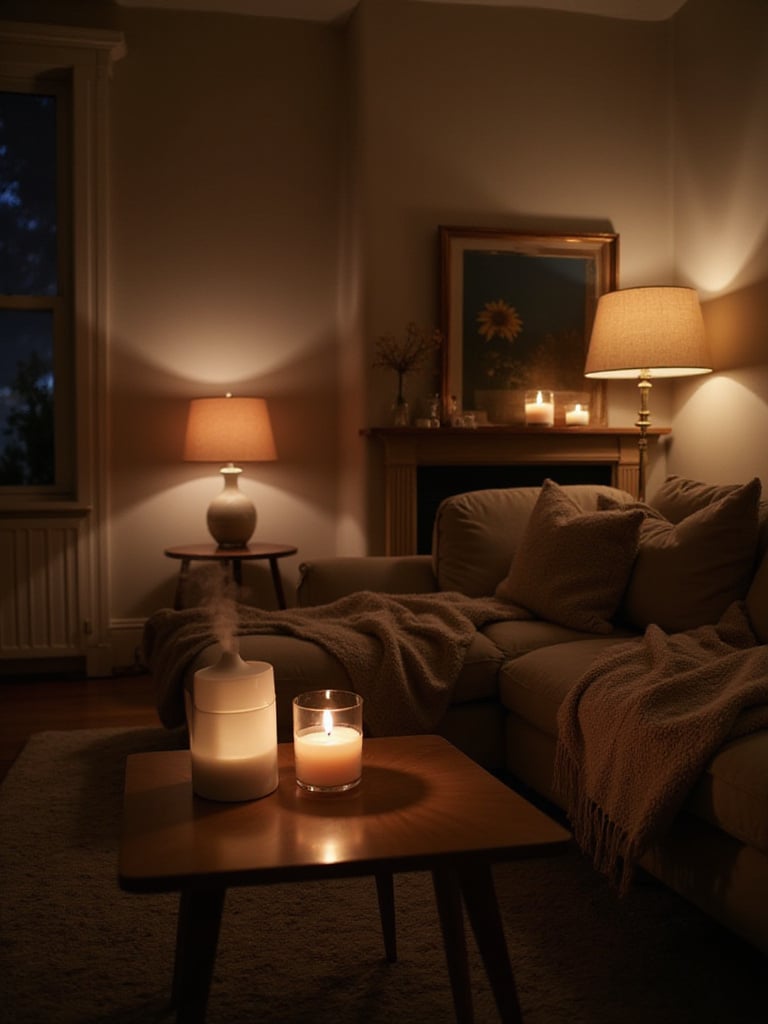
Choose scents that evoke comfort and warmth rather than clean or energizing fragrances. Vanilla, sandalwood, amber, cinnamon, and cedar create a sense of warmth and relaxation. Consider seasonal adaptations—lighter scents like lavender in summer, richer notes like clove or pine in winter. The method of diffusion matters too; candles provide both fragrance and that irreplaceable flickering light, while diffusers offer consistent scent without requiring attention.
The emotional response this evokes begins with a subtle invitation to relax. Our olfactory system connects directly to the brain’s limbic system—responsible for emotion and memory—making scent one of your most powerful tools for creating a truly personal cozy living room.
As morning light filters through, the texture of truly comfortable seating creates an irresistible invitation to linger. Deep Seating—sofas and chairs with seat depths of 24 inches or more—fundamentally changes how you interact with your living room. Instead of perching formally, you can truly settle in, curl up, and relax completely.
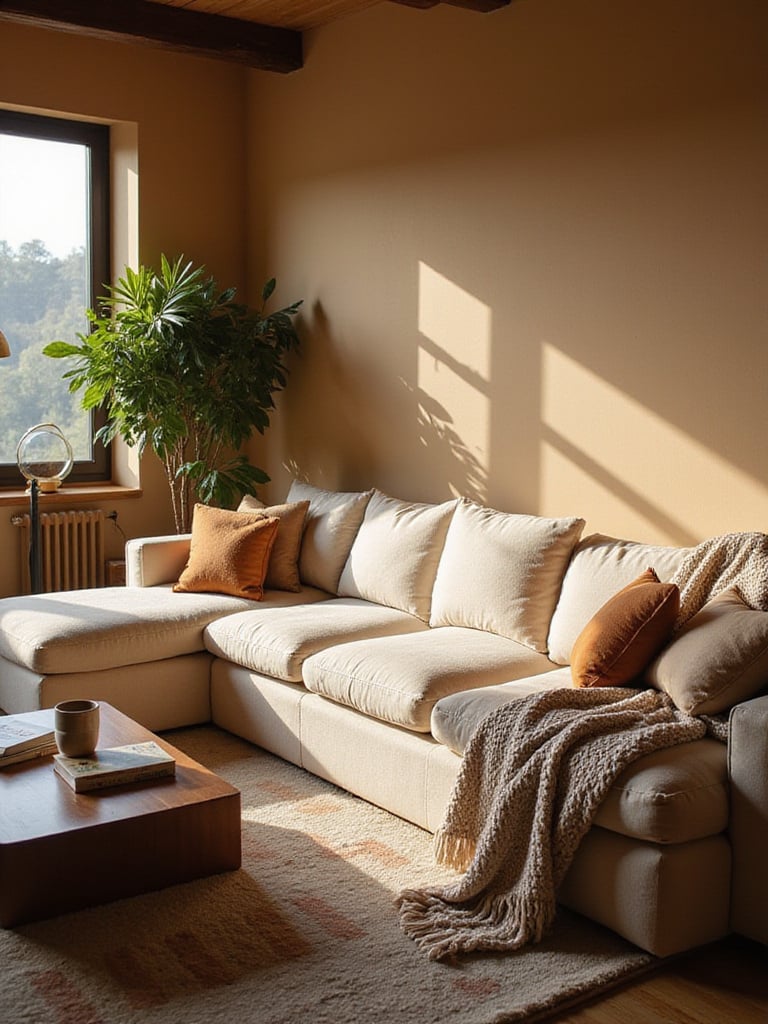
The physical experience of “sinking in” creates a psychological shift toward relaxation. Look for cushions with high-density foam cores wrapped in softer materials like down or fiber for the perfect balance of support and softness. Upholstery should be soft against skin—velvet, chenille, or performance fabrics with a gentle hand feel. Before purchasing, actually sit on the furniture in various positions to ensure it accommodates your favorite ways to relax.
“The difference between good seating and great seating isn’t how it looks—it’s how you feel after sitting there for two hours. Can you completely lose track of time? That’s the test.”
The craftsmanship behind these pieces began with understanding human behavior. We don’t just sit anymore—we lounge, recline, curl up with devices, and shift positions frequently. Truly cozy living room seating accommodates all these behaviors effortlessly.
What makes this design special is the way it carves out a personal sanctuary within the larger cozy living room. A reading nook is more than just a chair with a lamp—it’s a deliberate statement that slow, quiet activities deserve dedicated space in your home. This small gesture creates enormous impact on how you use and feel in your living area.
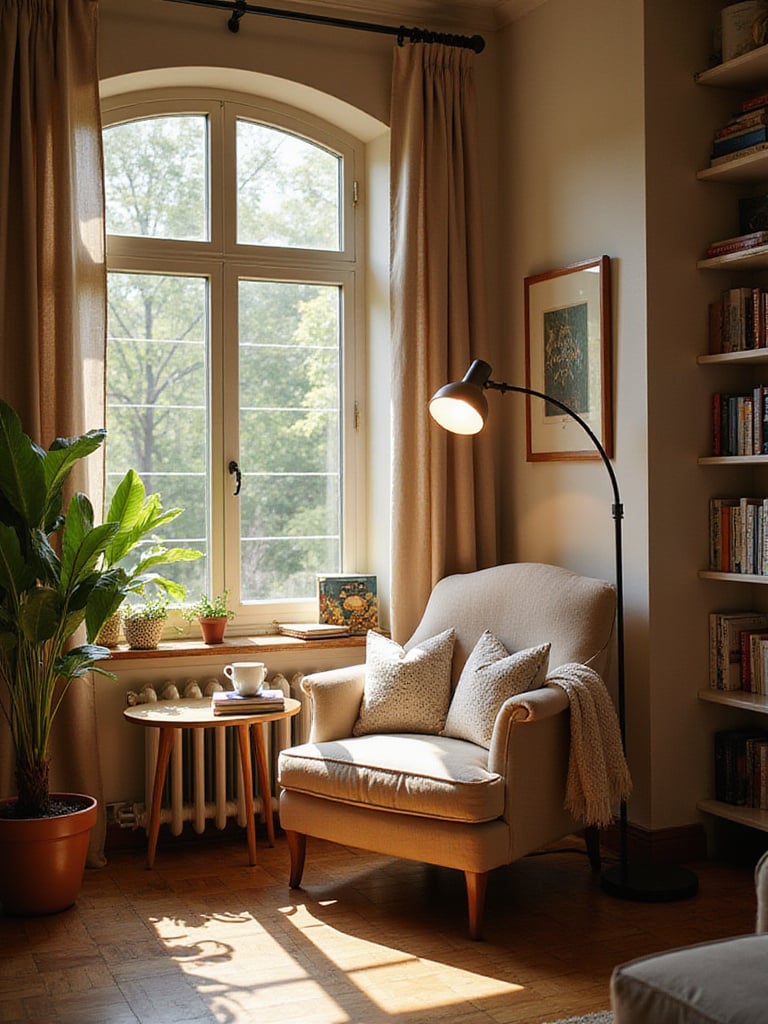
The essential elements are comfortable seating, adequate task lighting, and a surface for books or drinks. Position the nook near natural light if possible, perhaps by a window or in a corner away from the main traffic flow. The chair should be genuinely comfortable for extended sitting—an oversized armchair, a chaise lounge, or even a window seat piled with cushions. The lighting needs to be adjustable and positioned to illuminate your reading material without creating glare.
Beyond aesthetics, the ecological impact matters because this small space often becomes the most used area of your cozy living room—proving that thoughtfully designed smaller spaces often contribute more to our wellbeing than grand, rarely-used rooms.
The evolution of this trend reflects broader cultural shifts toward more personal, curated spaces. Your coffee table sits at the center of your cozy living room, making it prime real estate for expressing personality while maintaining function. A thoughtfully styled coffee table invites interaction and adds layers of visual interest at the heart of your seating arrangement.
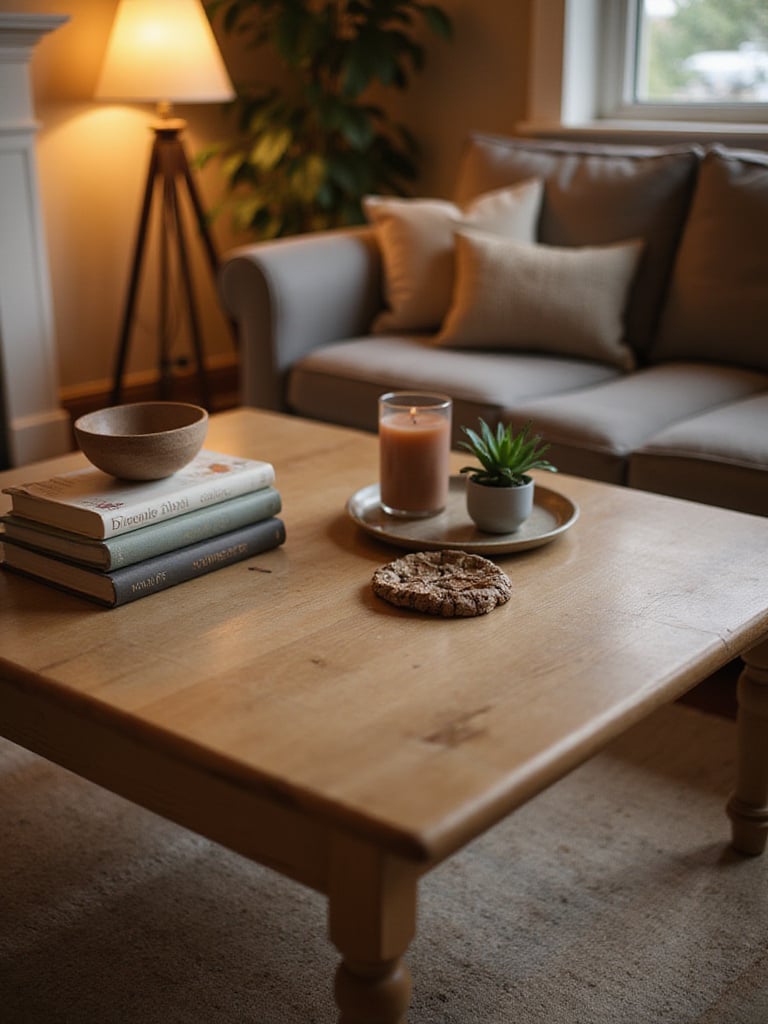
Start with a foundation piece—either a decorative tray to corral smaller items or a stack of 2-3 large, beautiful books that reflect your interests. Build around this anchor with varied heights and textures. Include something living (a small plant or fresh flowers), something personal (a meaningful object or collection), and something functional (coasters or a candle). The key is creating a composition that looks intentional without feeling precious or untouchable.
The maker’s journey from apprentice to master influenced how we approach these central surfaces. The best coffee table styling feels collected rather than purchased—a natural evolution of objects that have meaning rather than items bought specifically to fill space.
The unexpected design benefit comes from how curtains transform not just the windows but the entire feeling of your cozy living room. Soft, flowing window treatments diffuse harsh light, absorb sound, and add crucial texture to what might otherwise be hard, flat surfaces. They create a sense of gentle movement even when still, softening the overall feel of the space.
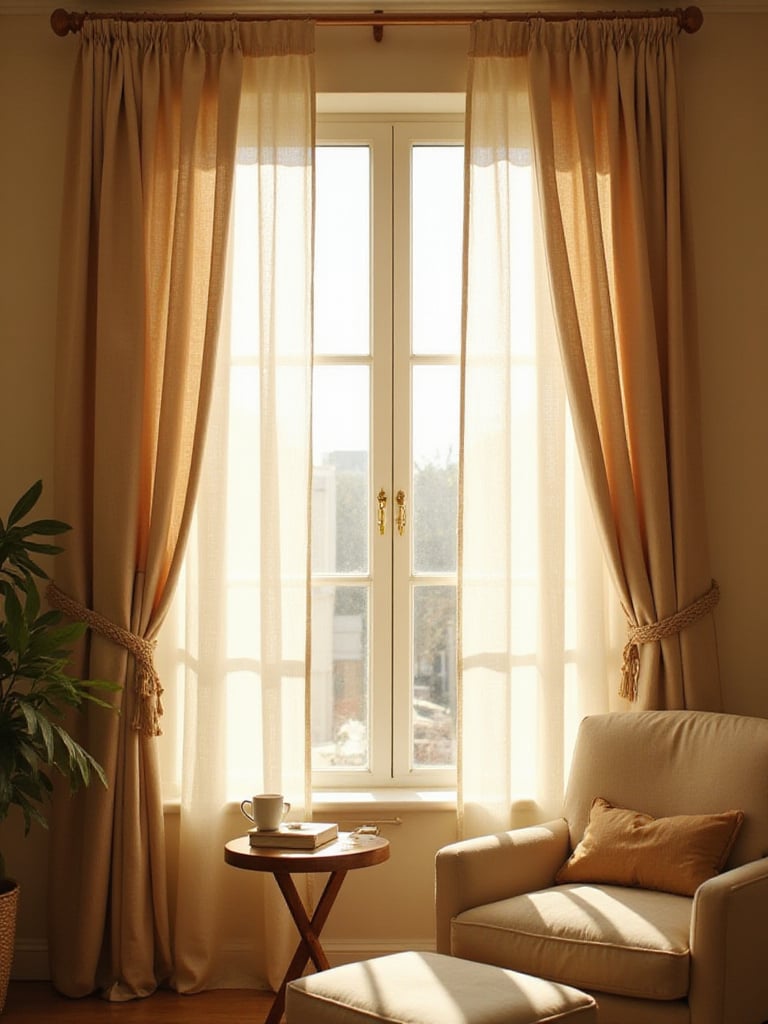
Choose fabrics with beautiful drape—linen, cotton velvet, or lightweight wool—that hang gracefully rather than stiffly. The length is crucial; curtains should either just kiss the floor or puddle slightly for maximum softness. Hang rods higher (4-6 inches above the window frame) and wider (extending 8-12 inches beyond each side) than the actual window to make windows appear larger and allow maximum light when curtains are open.
Running your hand across this material reveals its ability to transform not just how a room looks, but how it sounds and feels. Good curtains create a subtle cocoon effect that’s essential to a truly cozy living room.
The styling mistake most people make is assuming all seating needs to be at the same height. Floor cushions and poufs introduce a delightful informality that immediately makes a cozy living room feel more relaxed and accessible. These low seating options invite people to get comfortable in a different way—to literally come down to a more grounded, casual level.
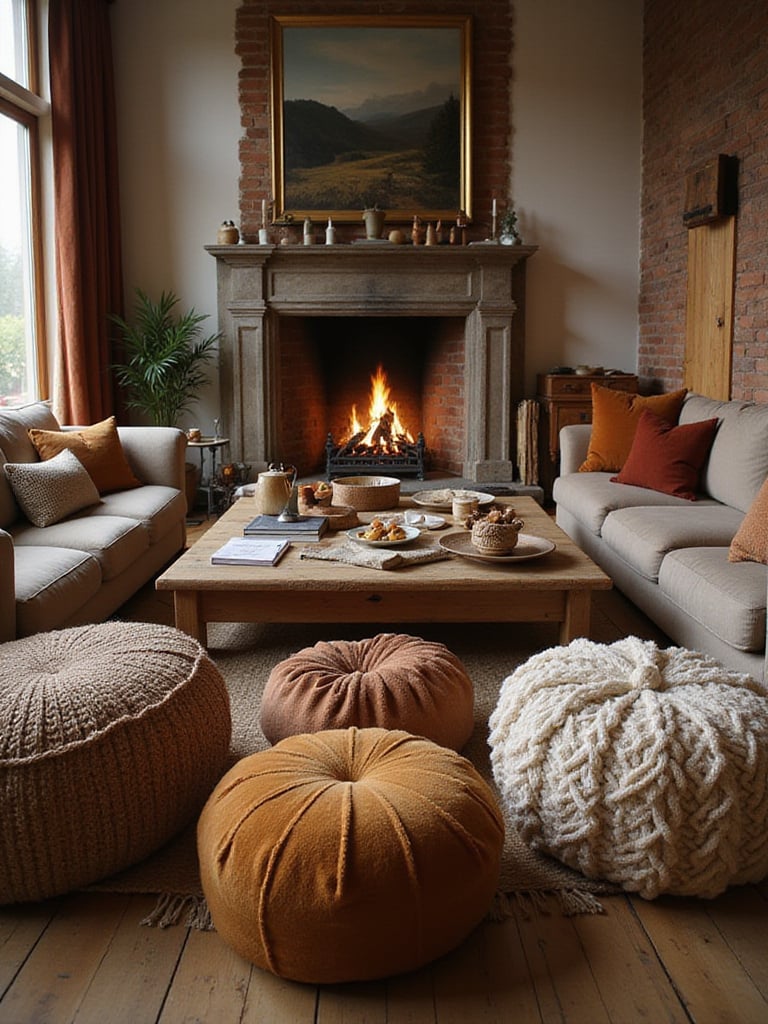
These pieces add tremendous flexibility to your space. Unlike heavy furniture, they can be easily moved to create conversation clusters, provide extra seating for gatherings, or create cozy corners for kids or pets. Look for substantial, well-made pieces in durable fabrics like velvet, corduroy, leather, or heavy-duty woven textiles that can withstand actual use.
The versatility reveals itself when you pair these informal seating options with your more structured furniture. The contrast between a tailored sofa and casual floor cushions creates visual and functional interest that makes your cozy living room feel more dynamic and welcoming.
If you’ve struggled with similar rooms before, a fireplace—whether real, gas, electric, or even decorative—can transform your cozy living room into a true sanctuary. The fireplace serves as both a visual focal point and a psychological anchor, creating an instant sense of warmth and gathering that’s deeply rooted in human experience. Our connection to fire as a source of warmth, light, and protection is primal and powerful.
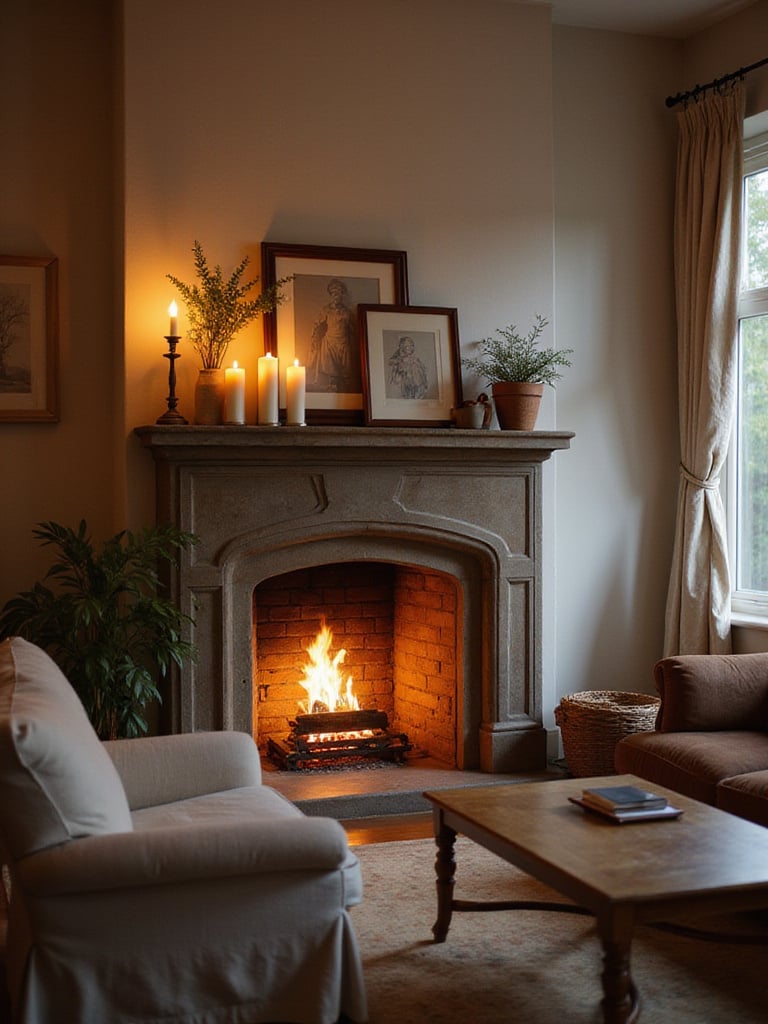
The options today are numerous, regardless of your home’s limitations. Traditional wood-burning fireplaces offer authentic crackling and scent but require proper ventilation. Gas fireplaces provide real flames with less maintenance. Electric versions need only a standard outlet and can be installed anywhere. Even non-functioning decorative fireplaces with candles or lights create the psychological effect of a hearth. The key is making this feature the heart of your Furniture Arrangement, positioning seating to face or flank the fireplace rather than treating it as a side element.
The traditional methods used result in a gathering place that naturally draws people together, creating the perfect foundation for a truly cozy living room where conversation and connection flourish.
When clients ask us about balancing style with comfort, decluttering always emerges as the critical first step. A truly cozy living room isn’t about abundance of stuff but rather about creating space for relaxation and connection. Clutter creates visual noise that prevents our brains from fully relaxing, while thoughtfully organized spaces allow both the eye and mind to rest.

Focus on high-impact areas first: coffee tables, console surfaces, entertainment centers, and flooring. Create systems for items that tend to accumulate, like remote controls, magazines, and everyday technology. The goal isn’t sterile minimalism but rather intentional curation—keeping what adds value and comfort while releasing what creates stress or distraction.
Many homeowners wonder how to maintain that peaceful feeling while actually living in their spaces. The answer lies in creating simple systems that make maintaining order easier than creating chaos—designated homes for everything and regular quick resets rather than major occasional overhauls.
The ambient experience changes the entire room’s energy with something as simple as the color temperature of your light bulbs. For a cozy living room, warm-toned lighting (2200K-2700K) is non-negotiable. These lower Kelvin temperatures produce golden light similar to sunset or candlelight, creating an instant sense of intimacy and warmth that cool-toned bulbs simply cannot achieve.

The psychological impact is significant—cool white or bluish light (above 3500K) signals our brains to be alert and active, while warm golden light tells our bodies to relax and unwind. Replace any “daylight” or “bright white” bulbs with those specifically labeled “warm white” or “soft white.” LED technology now perfectly mimics the warm glow of traditional incandescents while using less energy and lasting much longer.
For those worried about maintenance, today’s LED options offer the perfect warm glow while lasting years longer than traditional incandescent bulbs—making this one of the easiest and most impactful changes you can make to your cozy living room.
The tactile experience changes the entire room’s energy when you introduce layered rugs. This designer technique adds visual depth while creating zones of softness that literally feel different underfoot as you move through your cozy living room. The contrast between textures—perhaps a natural jute base with a softer wool or plush synthetic layered on top—creates both visual and physical interest.

The technique involves starting with a larger, often more neutral base rug that anchors the space, then adding a smaller, more textural or patterned rug on top. The bottom layer should extend beyond the furniture arrangement, while the top layer might sit just under the coffee table or in a conversation area. This layering adds insulation, sound absorption, and creates a more defined seating area within the larger room.
Beyond aesthetics, the ecological impact matters because layered rugs provide extra insulation against cold floors, potentially lowering heating costs while significantly increasing physical comfort in your cozy living room.
The sustainable journey of this simple addition involves recognizing that true comfort requires supporting your entire body. An ottoman or footrest allows you to elevate your legs, improving circulation and allowing deeper relaxation than sitting upright. This small addition transforms how you physically experience your cozy living room, encouraging longer periods of true relaxation.

Choose an ottoman that complements your primary seating in both height and style. Ideally, it should be slightly lower than your sofa or chair seat for optimal comfort. Consider multi-functional options—many ottomans offer hidden storage, can serve as coffee tables with a tray on top, or provide extra seating when needed. Upholstery should be durable but inviting; textured fabrics add visual interest while leather or performance fabrics offer practicality.
While trendy, this element has staying power because it addresses a fundamental human need for complete relaxation—something often overlooked in living rooms focused solely on conversation or television viewing.
Professional stylists approach this by first considering how a room will feel, not just how it will look. Tactile fabrics like velvet, chenille, and boucle engage our sense of touch, adding a crucial sensory dimension to your cozy living room. These materials invite interaction—you naturally want to run your hand across velvet’s smooth pile, sink into chenille’s soft tufts, or explore boucle’s interesting nubby texture.
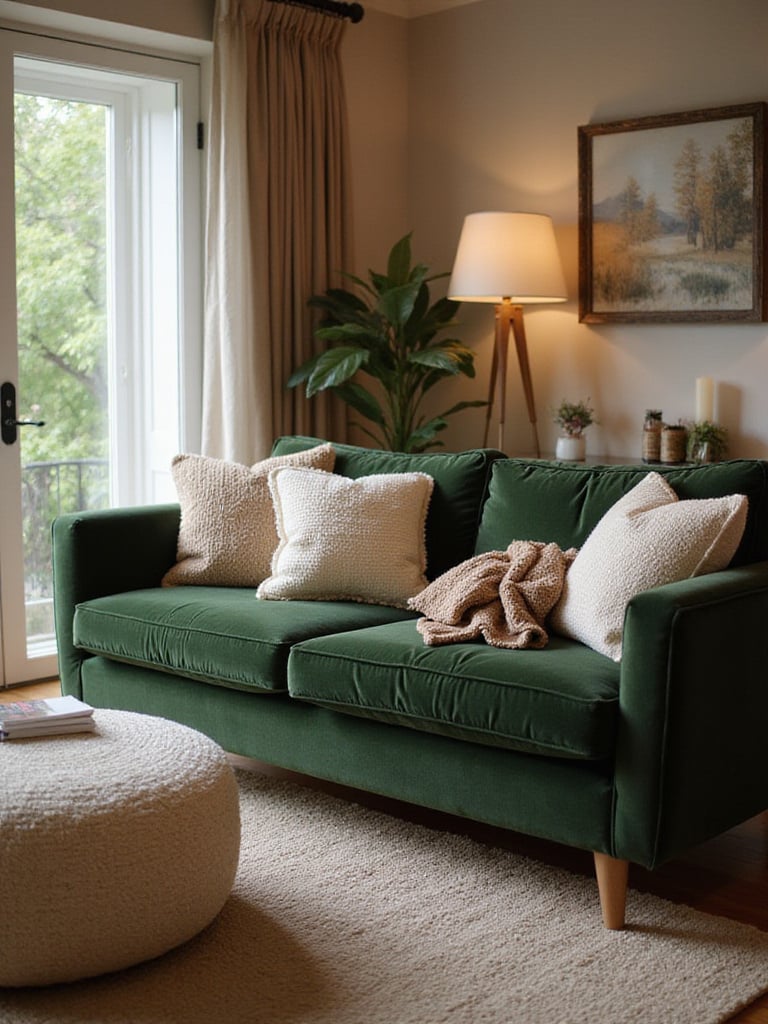
Each fabric brings different qualities: velvet offers luminous color depth and a smooth, luxurious hand feel; chenille provides soft, fuzzy comfort with subtle texture; boucle delivers interesting visual texture with its looped yarns. The key is using these fabrics strategically—perhaps velvet on a statement chair, chenille for throw pillows, and boucle on an ottoman. This variety creates a rich tactile landscape that makes the room feel more layered and inviting.
For those hesitant about bold patterns, textured solids offer a perfect solution—they add visual interest and depth without competing with other elements in your cozy living room.
The composition comes together when you identify and enhance one strong focal point that anchors your cozy living room. Whether it’s a fireplace, a stunning view, a large piece of art, or an architectural feature, this focal point gives the eye a place to rest and creates a natural organization for the entire space. Without it, rooms can feel scattered and unfocused.
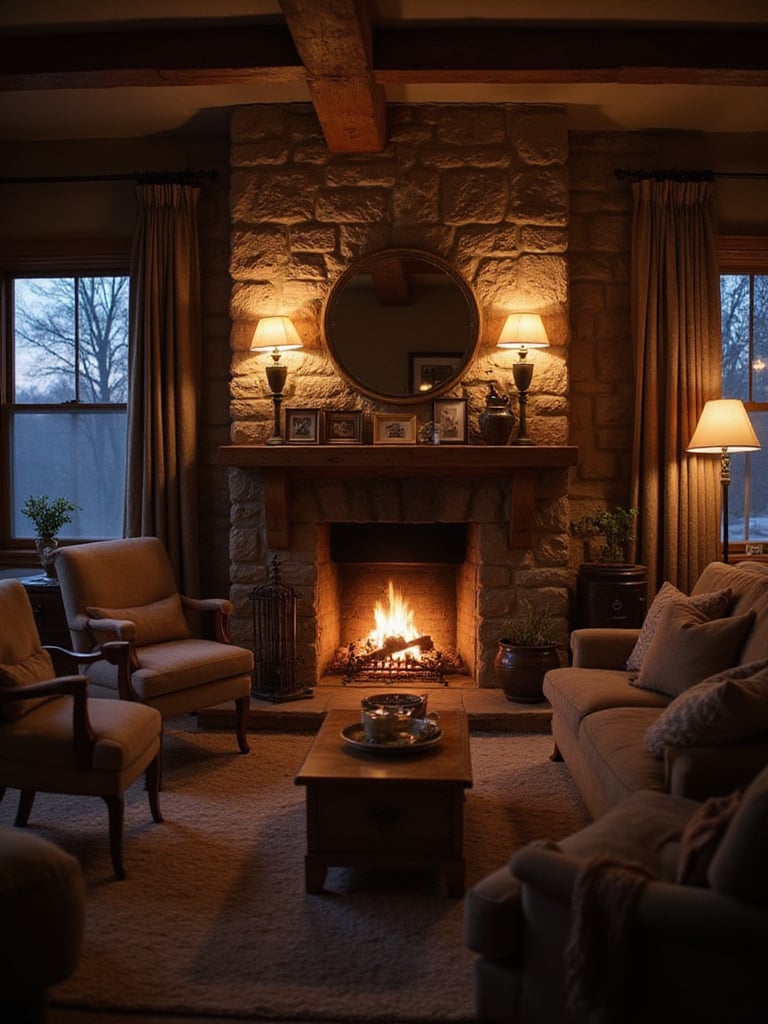
Enhance your focal point by arranging furniture to face or acknowledge it. If it’s a fireplace, position seating to enjoy it. If it’s a view, keep window treatments minimal and frame it thoughtfully. For an art piece, ensure proper lighting and complementary surrounding decor. The key is making this feature feel like the heart of the room—the element that gives purpose to the space and draws people in.
If your existing decor doesn’t seem to coordinate, start fresh by identifying what should be the star of your cozy living room, then build outward from there, allowing that central element to inform color choices, arrangement, and accessories.
The unexpected pairing that always works is combining books with personal treasures on shelves. This combination instantly adds warmth, personality, and lived-in comfort to any cozy living room. Unlike perfectly styled catalog displays, shelves filled with actual books you read and objects that tell your story create authentic character that can’t be replicated.

Start by removing everything and grouping books by size or color for visual cohesion. Arrange some vertically, others horizontally to create varied rhythm. Intersperse personal items thoughtfully—family photos, travel souvenirs, inherited pieces, or natural elements like plants or interesting stones. The key is balance; leave some empty space rather than cramming shelves full, and vary the arrangement to create visual movement.
The visual weight balances perfectly when you mix substantial elements like books with more delicate or intricate personal items, creating a display that feels both grounded and personal in your cozy living room.
The finishing touch that elevates the entire look comes through engaging another sense entirely—hearing. The right background sounds can transform how you experience your cozy living room, masking distracting noises and creating a sense of peaceful envelopment. This often-overlooked element adds tremendous depth to the sensory experience of your space.
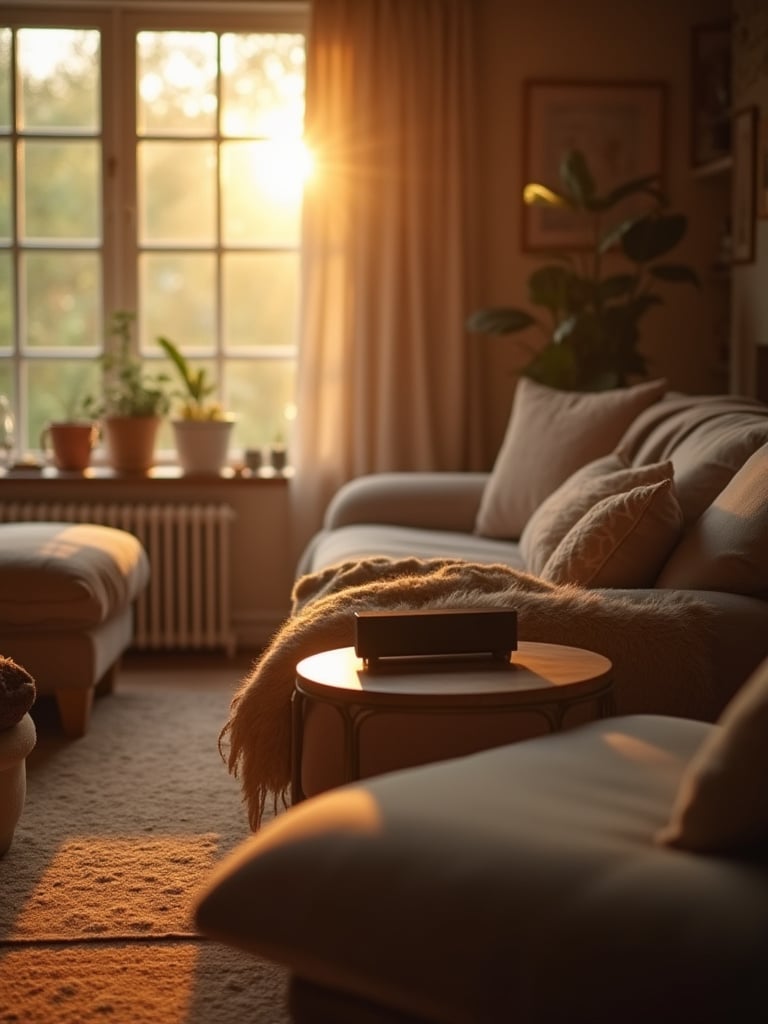
Choose sounds that create the atmosphere you want without demanding attention. Nature sounds like gentle rain or forest ambiance provide organic background texture. Instrumental music—whether classical, acoustic, jazz, or lo-fi—adds mood without the distraction of lyrics. The key is keeping volume low; these sounds should be felt more than actively heard, creating an acoustic backdrop that enhances rather than dominates the space.
Even in smaller spaces, the ambiance evolves throughout the day as natural light changes, and your sound choices can evolve too—perhaps gentle classical in the morning, soft jazz in the afternoon, and nature sounds in the evening to create different moods in your cozy living room.
The artisan collective that creates these pieces understands that organization can be beautiful as well as functional. Decorative trays transform necessary items from scattered clutter into intentional vignettes. They create boundaries that visually contain disparate objects, making surfaces look instantly more organized while adding another layer of texture and material to your cozy living room.

Choose trays that complement your decor style—wooden for warmth, metal for sleekness, rattan for natural texture, or lacquered for color and shine. Size matters; the tray should be large enough to hold necessary items without overwhelming the surface. Position trays on coffee tables, side tables, or ottomans to corral remotes, coasters, candles, and other small items that tend to create visual chaos.
The renewable resources used here demonstrate how practical organization doesn’t have to be plastic or utilitarian—beautiful, sustainable materials can serve functional purposes while enhancing the aesthetic of your cozy living room.
The materials are sourced from a remarkable region where nature creates art more beautiful than anything manufactured. Incorporating elements like smooth stones, interesting branches, or dried botanicals brings the calming presence of the outdoors into your cozy living room. These organic shapes and textures contrast beautifully with more structured furniture and decor, adding visual interest and a grounding connection to the natural world.

Look for pieces with interesting forms, textures, or colors that speak to you. Driftwood with smooth, weathered surfaces makes striking sculptural elements. River stones with varied colors and patterns can fill a decorative bowl. Dried seedpods, pinecones, or interesting branches can become natural art pieces. Clean these items thoroughly before bringing them indoors, and consider sealing wood pieces to prevent deterioration.
Layer in dimension by simply incorporating these found objects among more refined decor. The contrast between polished and raw, manufactured and natural creates dynamic tension that makes your cozy living room feel more interesting and authentic.
Creating a truly cozy living room isn’t about following rigid rules or purchasing specific items—it’s about understanding how different elements work together to create a feeling of warmth, comfort, and personal connection. By layering textures, controlling light, incorporating natural elements, and adding personal touches, you’ve created more than just an attractive space—you’ve built a sanctuary that supports both relaxation and creativity.
Remember that your cozy living room should evolve over time, reflecting your changing needs and tastes. Start with the elements that speak most strongly to you, whether that’s soft textiles, warm lighting, or comfortable seating. Pay attention to how different additions make you feel in the space, not just how they look. The most successful cozy living rooms are those that feel authentically connected to the people who live in them—spaces that welcome, comfort, and inspire in equal measure.